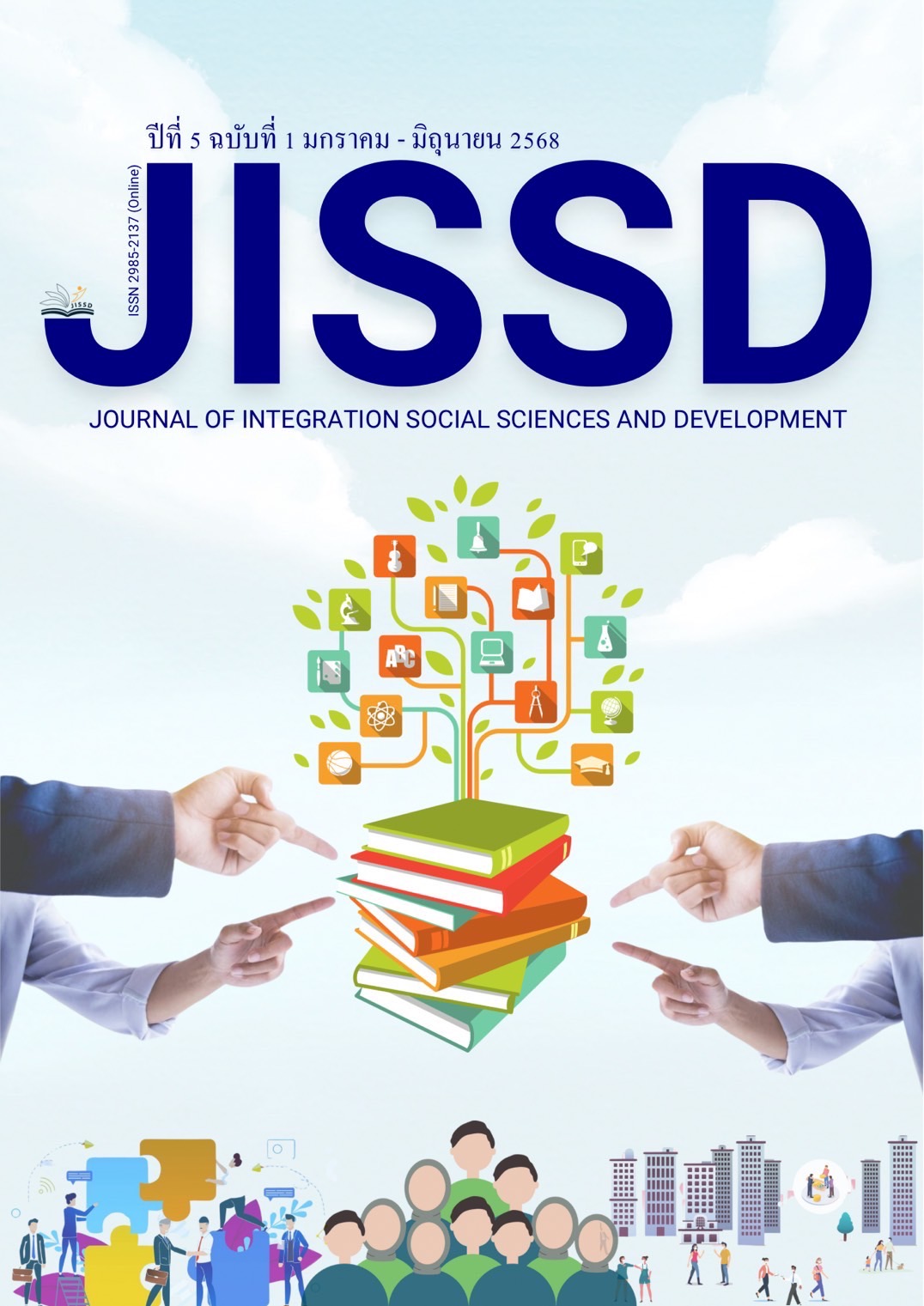Administration of the Child Development Center in the Digital Age under the Local Government of Sri Bunruang District, Nong Bua Lamphu Province
Main Article Content
Abstract
This study aimed to examine the administration of early childhood development centers in the digital era under the local administrative organizations in Sri Bunruang District, Nong Bua Lamphu Province, and to identify approaches for further development. The sample group consisted of 124 individuals, including acting headteachers, teachers, and caregivers in the 2024 academic year. Additionally, five experts were purposively selected for interviews. Research instruments included questionnaires and semi-structured interview forms. Quantitative data were analyzed using mean and standard deviation, while qualitative data were analyzed through content analysis.
The research findings indicate that the overall management of early childhood development centers in the digital era is at a high level. When considering each aspect, all were rated at a high level. The aspects, ranked from highest to lowest mean score, are as follows: professional development, public relations, digital vision, opportunity creation, promotion of learner engagement, and adaptation of the learning environment.
The development approaches are as follows: (1) Enhancing knowledge through hands-on training, providing appropriate tools, and establishing learning communities to exchange experiences in digital teaching. (2) Procuring and developing diverse, modern, and conducive learning resources, such as smart classrooms, digital libraries, and creative spaces, to promote effective learning in the digital era. (3) Utilizing suitable platforms to create engaging, creative, and positive content with proper monitoring and content control before dissemination to enhance the institution's reputation and credibility. (4) Emphasizing learning through play, exploration, and direct experiences, such as project-based activities, learning centers, and simulations, to naturally develop children's skills and creativity. (5) Implementing child-centered management approaches, developing teacher expertise, fostering a safe and stimulating learning environment, and integrating appropriate technology and innovations for early childhood education. (6) Promoting the continuous professional development of teachers and staff through hands-on training, lifelong learning, and Professional Learning Communities (PLC), along with supporting research and innovation in early childhood education.
Article Details
References
กระทรวงศึกษาธิการ. (2560). หลักสูตรการศึกษาปฐมวัย พุทธศักราช 2560. สำนักวิชาการและมาตรฐานการศึกษา สำนักงานคณะกรรมการการศึกษาขั้นพื้นฐาน กระทรวงศึกษาธิการ.
กิ่งกาญจน์ สุขสำราญ. (2565). ภาวะผู้นำทางวิชาการของผู้บริหารสถานศึกษาในกลุ่มอำเภอ ปลวกแดง สังกัดสำนักงานเขตพื้นที่การศึกษาประถมศึกษาระยอง เขต 1. วิทยานิพนธ์ปริญญาศึกษาศาสตรมหาบัณฑิต สาขาการบริหารการศึกษา มหาวิทยาลัยเกริก.
กรมส่งเสริมการปกครองท้องถิ่น กระทรวงมหาดไทย. (2560). คู่มือศูนย์พัฒนาเด็กเล็กสังกัดองค์กรปกครองส่วนท้องถิ่น. กรุงเทพฯ.
ณัฐกฤตา กันทาใจ. (2565). การบริหารสถานศึกษาในยุคดิจิทัลของผู้บริหารสถานศึกษาโรงเรียนขยายโอกาสทางการศึกษา อำเภอพาน จังหวัดเชียงราย สังกัดสำนักงานเขตพื้นที่การศึกษาประถมศึกษาเชียงราย เขต 2. การศึกษาค้นคว้าด้วยตนเองหลักสูตรปริญญาการศึกษามหาบัณฑิต สาขาวิชาการบริหารการศึกษา มหาวิทยาลัยพะเยา.
พระพิทักษ์ จนฺทโร (รอดบุญธรรม). (2566). การบริหารสถานศึกษาในยุคดิจิทัลตามหลักไตรสิกขา ของผู้บริหารสถานศึกษาในสังกัดสำนักงานเขตพื้นที่การศึกษามัธยมศึกษาจังหวัดขอนแก่น. วิทยานิพนธ์หลักสูตรปริญญาครุศาสตรมหาบัณฑิต สาขาวิชาพุทธบริหารการศึกษา มหาวิทยาลัยมหาจุฬาลงกรณราชวิทยาลัย.
พระราชบัญญัติสภาตำบลและองค์การบริหารส่วนตำบล (แก้ไขฉบับที่ 7) พุทธศักราช 2562. (2562). ราชกิจจานุเบกษา 136. (เมษายน 2562): หน้า 158.
พระราชบัญญัติเทศบาล (แก้ไขฉบับที่ 13 ) พุทธศักราช 2552. (2552). ราชกิจจานุเบกษา 136. (กุมภาพันธ์ 2552): หน้า 14.
พระราชบัญญัติกำหนดแผนและขั้นตอนการกระจายอำนาจให้แก่องค์กรปกครองส่วนท้องถิ่น พุทธศักราช 2542, 2542 :
พรทิพย์ ไพรัตน์. (2564). การพัฒนาการบริหารสถานศึกษาอัครสังฆมณฑลสู่ความเป็นเลิศในทศวรรษหน้า. วารสารสังคมศาสตร์และมานุษยวิทยาเชิงพุทธ, 6(3), 165-177.
มลฤดี เพ็งสง่า และมัทนา วังถนอมศักดิ์. (2566). การบริหารสถานศึกษายุคดิจิทัล. วารสารวิชาการศึกษาศาสตร์ ศรีนครินทรวิโรฒ, 24(2), 162-175.
รัฐธรรมนูญแห่งราชอาณาจักรไทย พุทธศักราช 2560. (2560). ราชกิจจานุเบกษา 143. (เมษายน 2560). หน้า 74-75.
ศิรดา เกตุนิ่ม. (2565). แนวทางการบริหารศูนย์พัฒนาเด็กเล็กสังกัดองค์กรปกครองส่วนท้องถิ่นในยุคนิวนอร์มัล เขตอำเภอหัวไทร จังหวัดนครศรีธรรมราช. วิทยานิพนธ์หลักสูตรปริญญาครุศาสตรมหาบัณฑิต สาขาวิชาพุทธบริหารการศึกษา มหาวิทยาลัยมหาจุฬาลงกรณราชวิทยาลัย.
ศิริวรรณ อยู่ถมยา, สังวาร วังแจ่ม ทัศนีย์ บุญมาภิ และสุรศักดิ์ สุทธสิริ. (2567). การบริหารศูนย์พัฒนาเด็กเล็กสู่ความเป็นเลิศในยุคดิจิทัลของสถานศึกษาสังกัดองค์กรปกครองส่วนท้องถิ่นในเขตอำเภอบางมูลนาก จังหวัดพิจิตร. วารสาร มจร อุบลปริทรรศน์, 9(1), 1587-1598.
สุกัญญา แช่มช้อย. (2562). การบริหารสถานศึกษาในยุคดิจิทัล. กรุงเทพฯ: โรงพิมพ์แห่งจุฬาลงกรณ์มหาวิทยาลัย.
อนันต์ วรธิติพงศ์. (2561). การศึกษารูปแบบดิจิทัลเทคโนโลยีเพื่อการศึกษาสำหรับการศึกษาขั้นพื้นฐาน. Veridian E-Journal Science and Technology Silpakorn University, 11(2), 1200-1215.
Cronbach, L. J. (1990). Essentials of psychological testing (5th ed.). New York : Harper Collins.
Krejcie, R.V., & D.W. Morgan. (1970). Determining Sample Size for Research Activities. Educational and Psychological Measurement, 30(3), 607 – 610.


